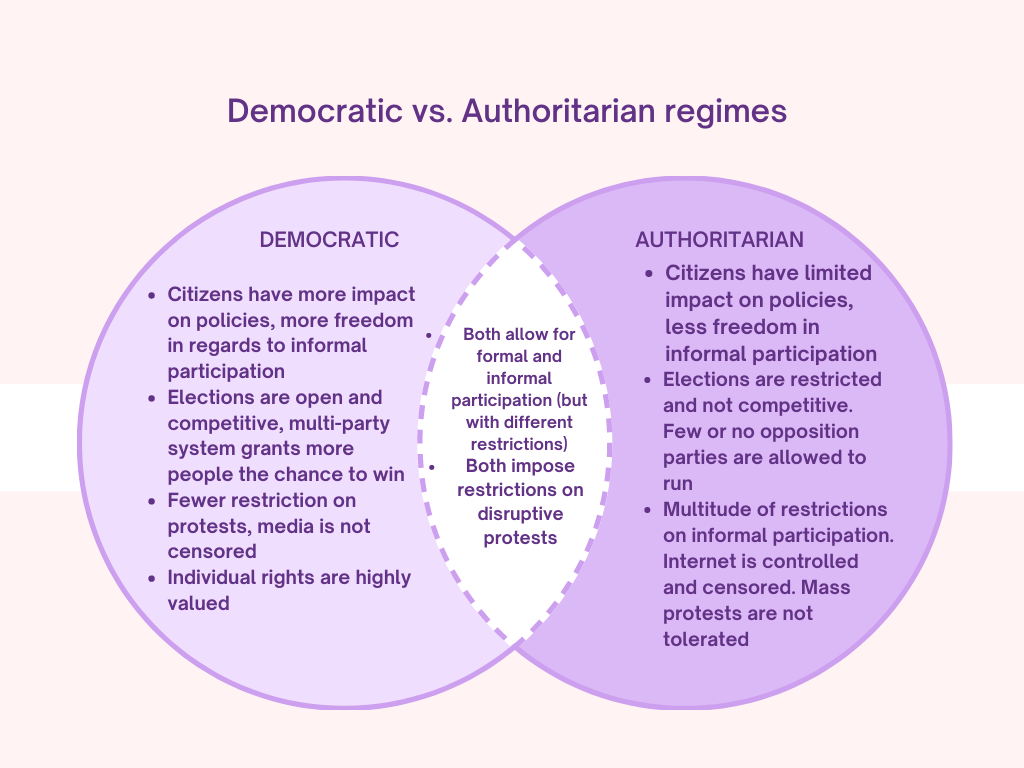3.6 Forces that Impact Political Participation
3 min read•june 18, 2024
Isabela Padilha
Kelly Cotton
AP Comparative Government 🗳️
90 resourcesSee Units
Unit 3 - Forces that Impact Political Participation
In Topic 3.5, we focused on the nature and role of political participation in various regimes. We learned about the types of political participation, including voting and protests. We learned why participation can turn violent. In Topic 3.6, we will focus our attention on how political participation affects and is affected by authoritarian and democratic regimes. For this topic, a side by side comparison seems the best way to explore the information that you need to be successful on the exam!
Political Participation
Before we analyze the table below, it is important that we understand the distinctions and similarities of political participation in each regime. So, here is a venn diagram that analyzes that:

Now, we will look at our course countries and explore an example of each!
Forces of Political Participation - Course Countries
| Country | Regime | Example |
| UK 🇬🇧 | Democratic | In the UK, there is a direct election of parliament members, referenda, civil society is well-established and protests are considered legitimate. |
| Mexico 🇲🇽 | Democratic | In Mexico, there is a direct election of the President and members of the legislature. Although the country is still in the process of fully democratizing, but before the 1990s the political participation that opposed the predominant party (the PRI) was highly condemned. |
| Iran 🇮🇷 | Authoritarian | In Iran there are similar restrictions to voting as in democratic countries. For instance, you must be over 18 to vote for President or the parliament. However, there is not a great variety of parties and candidates and elections are not as competitive. In addition, Iran is notorious for suppressing mass protests and censoring the media to favor the ruling party/ideology. The Iranian government has shut down the internet for days as an attempt to restrict civil society and access to information. |
| China 🇨🇳 | Authoritarian | In China, there is essentially no opposition to the ruling party. The population does not directly select the President. Protests are highly suppressed, such as the 1989 Tiananmen square massacre which ended up in the killing of several people that were engaging in pro-democracy protests. |
| Nigeria 🇳🇬 | Democratic | Although Nigeria is an emerging democracies, it exhibits the presence of a multitude of parties that have been elected in the 21st century. There are also common democratic restrictions, such as age, for citizens to be able to vote. The Constitution protects the right for protests and peaceful assemblies. |
| Russia 🇷🇺 | Authoritarian | In Russia the population has the ability to vote for the President and the Legislative. Although protests have occurred, in 2012 Russia has passed legislation to criminalize large gatherings. Protests in Chechnya led to Russia troops invading the region and Putin appointed a leader to oversee Chechnya. |
It is time to move onto Topic 3.7 which is focused on the extent to which regimes protect or restrict civil liberties and civil rights. This is a natural transition after our discussion of political participation in authoritarian and democratic regimes. ➡️
Browse Study Guides By Unit
👑Unit 1 – Political Systems, Regimes, & Governments
⚖️Unit 2 – Political Institutions
🙋♀️Unit 3 – Political Culture & Participation
🐘Unit 4 – Party, Electoral Systems, & Citizen Organizations
🏗Unit 5 – Political & Economic Changes & Development
🤔Exam Skills
📚Study Tools

Fiveable
Resources
© 2025 Fiveable Inc. All rights reserved.